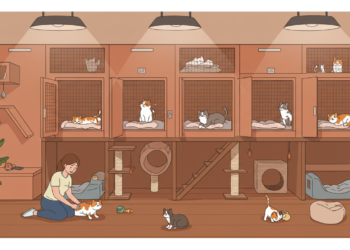Proper coat care is very important for both (semi) long-haired and short-haired cat breeds. It prevents health and behavioural problems. It is nice for all breeds that they come through the moult faster if they are combed regularly. The chance of hairballs also decreases.
For (semi) long-haired variants it is also important that tangles and matting of the coat are prevented. This can lead to serious health and behavioural problems due to the skin becoming suffocated and very painful for the cat. If you have trouble keeping up with the coat yourself or if it is a lot of work, you can also go to a groomer a few times a year.
General coat care
In general, it can be said that a cat’s coat should be combed or brushed at least once a week. There are different types of brushes and combs that are suitable. A boar bristle brush and metal comb are recommended for most coats.
Combing or brushing is not only good for the coat, but also for the social aspect. It strengthens the bond between you and your animal. Your cat will also get used to being handled and touched. This is good because a visit to a vet or groomer will cause less stress.
Reading suggestions;200+ Unique Female Cat Names for Your Cute Companion
Weekly combing also helps you get to know your cat’s coat and skin better. If, for example, the cat develops a skin condition, you will discover this sooner and so you can take action faster.
trimming
Most cats, both short- and (semi-)long-haired, have an undercoat and during the moulting periods, many dead hairs are shed. A cat cannot remove all these hairs itself and the chance of hairballs increases. It is then advisable to take the cat to a groomer. The trimmer can deww/pluck the cat and thus get rid of the many dead hairs.
Due to all the dead hairs, the coat becomes matte in colour and loses its shine. After a good trim, the coat will be more intense in colour and shiny again. It also has the advantage for you that you will find much less hair in the house and keeping track of the coat will be easier.
Coat care by breed
A coat can be short or long, but also have a lot or little undercoat. Some coats are silky soft and others stiff. Therefore, take a good look at which coat your cat has and adjust the coat care accordingly.
Abyssinian
An Abyssinian has a coat that is fairly easy to care for. Brush the coat occasionally with a pig or boar bristle brush. During the moulting period, you can remove the dead and loose undercoat with a rubber brush. Finally, you can comb the fur with a fine comb. With a damp washcloth, you can remove the last hairs and the coat will shine nicely.
American Bobtail
The name for this breed is an American stump-tailed cat and there is a short-haired and a long-haired variant. The undercoat is full and can cause tangles, especially during the moulting period. That is why this breed must be well combed daily during the moult. Outside the moulting period, once a week is sufficient. Also, comb the long-haired variant with a metal comb and make sure that you go through the hair just above the skin to prevent tangles.
American Curl
The name for this breed is American Curly Cat and it also has a short-haired and long-haired variant. The coat will not tangle very quickly because there is little undercoat. For both coat types, it is sufficient to comb them once a week.
American Shorthair
The name for this breed is American Shorthair. Brushing the coat once a week is enough. For example, do this with a bristle brush. Especially during the moulting period, it is advisable to also comb with a metal comb and/or a rubber brush.
American Wirehair
The name for this breed is American Wirehair. The hair is spiral and the coat is woolly and frizzy. The fur care is okay. Brush well every week and comb with a wide-toothed comb. Points of attention are the groin and the pants.
American Burmese
The Burmese do not have a difficult coat. Brush these every week with a boar bristle brush. A damp chamois over it gives the coat extra shine.
Reading suggestions; Getting a cat: Which character traits suits you best?
Asian
Asian is the collective name for cats of the Burmese type that have a different coat colour. Brushing once a week with a boar bristle brush is sufficient. For the extra shine, you can run a damp chamois over the coat.
Balinese
The Balinese is Siamese with longer hair. The coat is shorter than that of other semi-long-haired cats. Because there is a little undercoat, brushing once a week with a boar bristle brush is sufficient. After-combing can be done with a metal comb.
Bengal
The Bengal does not have a difficult coat. Brush these every week with a boar bristle brush. A damp chamois over it gives the coat extra shine.
Russian Blue
Brush the coat weekly with a boar bristle brush. Don’t do this too thoroughly. The fur doesn’t benefit from that. Rub with a damp chamois for a nice shine.
Bombay
Brush the coat once a week and cover it with a damp chamois for a nice shine. If the cat needs to be bathed, let the coat air dry in a warm room to prevent a dull coat.
bohemian Rex
This curly coat requires a lot of attention and care. It tends very much to tangles and felts. Comb the coat down to the skin twice a week. Comb more intensively during the moulting period. It is advisable to have the undercoat plucked by a trimmer a few times a year.
British shorthair
The coat of the British Shorthair requires little care. Brush once a week with a boar bristle brush. In the moulting period (spring and autumn) a rubber brush is good to remove dead and loose hair. A metal comb can also help with this.
Burmese
Brush the coat once a week and cover it with a damp chamois for a nice shine. If the cat needs to be bathed, let the coat air dry in a warm room to prevent a dull coat.
Burmilla
Brush the coat once a week and cover it with a damp chamois for a nice shine. If the cat needs to be bathed, let the coat air dry in a warm room to prevent a dull coat.
Ceylon cat
Brush the coat once a week and cover it with a damp chamois for a nice shine. In the moulting period (spring and autumn) a rubber brush is good to remove dead and loose hair. A metal comb can also help with this.
Chartreux (Carthusian)
Brushing the coat once a week with a boar bristle brush is sufficient. In the moulting period (spring and autumn) a rubber brush is good to remove dead and loose hair. A metal comb can also help with this.
Cornish Rex
The undercoat is shorter than a shorthair coat and requires little maintenance. They have no top hair. Brushing once a week with a soft brush is sufficient.
Cymric
This is the long-haired variety of the Manx. They have a thick undercoat and a wiry outer coat. The coat should be brushed regularly with a pin brush and then with a wide-toothed comb. Do not do this too intensively as this can damage the coat.
Devon Rex
Unlike the Cornish Rex, this variant has top hair and waves. Brushing once a week is sufficient. Because they sometimes produce too much sebum, it is wise to wash this species every now and then.
Don Sphynx
Because of the sebum production and the absence of (many) hairs, it is wise to wash this breed weekly with a special shampoo. This prevents sticky and smelly skin. There is a lot of sebum between the toes and the cuticles. You can also clean this with special wipes.
Egyptian Mau
Brushing once a week with a boar bristle brush is sufficient. Use a metal comb to comb through and use a damp chamois to give the coat extra shine.
European Shorthair
Brush once a week with a boar bristle brush. Especially during the moulting period, combing with a metal comb can also help. If the cat has a lot of undercoats, a visit to a groomer can also help.
Exotic
The coat is lush and stands away from the body. The bristles are very dense and require more maintenance. Brushing once a week is definitely necessary and during the moulting periods this should be done more often. You can comb with a metal comb. To prevent problems, it is wise to have the undercoat plucked by a trimmer 2 to 4 times a year.
German Rex
This breed has a short and thick coat. It is silky and fine and has no top hair. The undercoat is shorter than the average short-haired cat and requires little maintenance. Brushing once a week with a soft brush is sufficient. Do not brush too intensively to prevent damage to the coat.
Havana Brown
Comb out the coat once a week with a fine-toothed comb. Rub with a damp chamois for a nice shine.
Sacred Birman
Tangles are less common in this breed. Brush once a week with a soft brush.
Highland Fold
This is the long-haired variety of the Scottish Fold. Brush the coat every week with a pin brush.
honey bear
The Honeybear’s coat does not tangle and is easy to comb. Brush once a week.
Japanese bobtail
Also called the Japanese stump-tailed cat. The coat is not very thick and does not tangle easily. Brushing once a week should be sufficient.
Korat
Brush once a week and during the shedding period (spring and autumn) a rubber brush is good to remove dead and loose hair. Rub with a damp chamois to give the coat extra shine.
Kurilian Bobtail
The coat is not that thick and does not tangle easily. Brush the coat once a week.
LaPerm (Oregon rex)
This breed exists in the long- and short-haired variant. To avoid disturbing the structure of the hair, comb every week with a wide-toothed comb. The cat should therefore not be brushed. Occasional washing is recommended. Then let the coat air dry so that the curl returns nicely.
Maine Coon
Brushing and combing once a week should be enough to prevent tangles. To do this, use a pin brush that is not sharp at the end. Comb after using a metal comb (shepherd’s rake).
Manx
The Manx has a soft, thick undercoat and a wiry outer coat. Brush once a week with a soft brush. Comb with a metal comb. In the shedding period (spring and autumn) a rubber brush is good to remove dead and loose hair. Do this with the hair growth and not too intensively to prevent damage to the coat.
Munchkin
Brush and comb with a wide-tooth comb once a week.
Nebelung
Comb once a week with a tooth comb.
Norwegian Forest Cat
Brush once a week. The lighter colours have a somewhat more brittle coat. During the moulting period, the undercoat sheds a lot of hair. This can cause tangles. During the moulting period, a daily comb is recommended. Do not work too intensively to avoid damage. A visit to a groomer can also be very wise.
Ocicat
This coat requires very little grooming. Occasional combing and brushing is sufficient.
Oriental Shorthair
This coat hardly sheds. Brush once a week with a soft brush.
Oriental Longhair
Tangles and felting are almost non-existent with this coat. Brush once a week with a boar bristle brush.
Persian Longhair
This coat requires a lot of care because it tends to tangle and felt. Comb the coat well twice a week with a metal comb. Comb the fur down to the skin. During the moulting period, you will have to comb more often. Having a groomer plucked and groomed two to four times a year can prevent many problems.
Peterbald
Because of the sebum production and the absence of (many) hairs, it is wise to wash this breed weekly with a special shampoo. This prevents sticky and smelly skin. There is a lot of sebum between the toes and the cuticles. You can also clean this with special wipes.
Pixie Bob
For the long- and short-haired variant, weekly brushing is sufficient.
ragdoll
Brush and comb well once a week. Comb and brush more often during the moulting period. The Ragdoll then sheds a lot of undercoats in a short time. It is wise to take the cat to the groomer during these periods to pluck/de-wool the undercoat.
Savannah
Brush once a week. In the shedding period (spring and autumn) a rubber brush is good to remove dead and loose hair. Also, use a damp chamois to give the coat extra shine.
Scottish Fold
The Dutch name for this breed is Scottish Fold Cat and it is the short-haired variant of the Highland Fold. Comb once a week with a wide-tooth comb is sufficient. Comb more often during the shedding period. A rubber brush can help to remove loose hair.
Selkirk Rex
This breed is and in a long- and short-haired version. The hair waves. Brush them with a wide-tipped comb with a round, soft tip or with a wide-tooth comb. During the moulting periods, the cat will have to be combed more often. Do not comb too intensively to avoid damage and also to prevent the curl from being pulled out.
Siamese
This coat is very short and has a little undercoat. Brush gently once a week. Loose hairs are easy to remove with a damp chamois.
Singapore
Comb once a week with a dust comb. A damp chamois gives the coat a nice shine.
snowshoe
Comb once a week and during the moulting periods, the dead and loose hairs are easy to remove with a rubber brush.
Sokoke
This breed has little to no undercoat. Brushing once a week is enough. A damp chamois provides an extra shine.
Somali (long-haired Abyssinian)
Comb through with a rake or comb once a week. Comb more often during the moulting period.
sphynx
Because of the sebum production and the absence of (many) hairs, it is wise to wash this breed weekly with a special shampoo. This prevents sticky and smelly skin. There is a lot of sebum between the toes and the cuticles. You can also clean this with special wipes.
Thai
This coat care has no undercoat. Brush occasionally with a soft brush.
Tibetan (semi-long-haired Tonkinese)
This coat care has no undercoat. As a result, tangles do not quickly develop and will hardly shed. Brushing once a week is more than enough.
Tonkinese
Brushing gently once a week is enough. During the moulting period, a rubber brush is easy to remove dead and loose hair. A damp chamois gives the coat a nice shine.
Toyger
Brush once a week. A damp chamois provides extra shine and immediately takes loose hair with it.
Turkish Angora (Anatolian Cat)
Brushing once a week is enough. Tangles do not develop quickly because the Turkish Angora does not have an undercoat. During the moulting period, dead and loose hairs can be removed with a rubber brush.
Turkish Van
Brush once a week. Brush more often during the moulting period because then a lot of undercoats comes off in a short time. A visit to the groomer can be wise during these periods.
Ural Rex
This thick, double and curly coat needs to be well combed and brushed.










